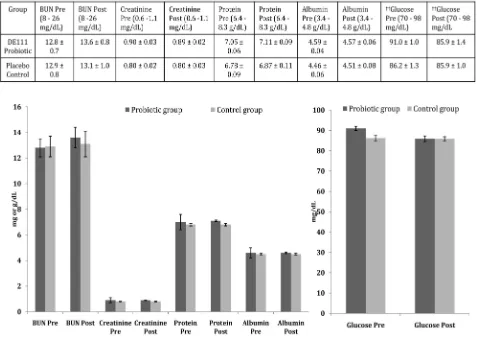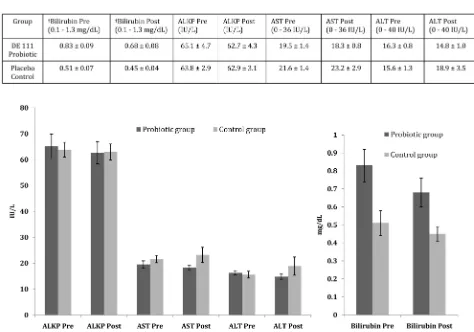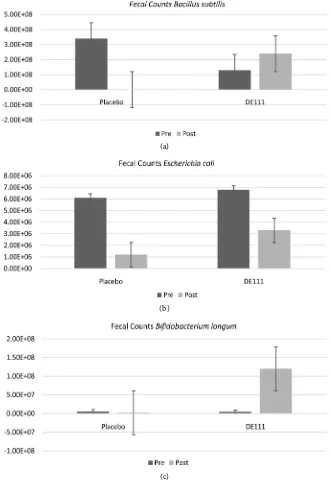ISSN Online: 2157-9458 ISSN Print: 2157-944X
DOI: 10.4236/fns.2019.106046 Jun. 24, 2019 626 Food and Nutrition Sciences
Tolerance and Effect of a Probiotic Supplement
Delivered in Capsule Form
Gina Labellarte, Margaret Maher
Biology Department, University of Wisconsin, La Crosse, USA
Abstract
Probiotic supplements have shown benefits in increasing frequency and effi-ciency of bowel movements and some strains have shown to reduce serum glucose levels. Bacillus subtilis is used in the fermentation of some foods for probiotic effects and may be useful in concentrated supplement form. The first objective of this clinical study was to determine if daily consumption of Bacillus subtilis strain DE111 at a dose of 5 × 109 CFU is safe for human con-sumption. The second objective was to determine the effectiveness at in-creasing frequency of normal bowel movements and improving consistency of bowel type, by increasing beneficial gut microbes and reducing pathogenic ones. The tolerance and efficacy of encapsulated Bacillus subtilis DE111 was assessed in an average 20-day double-blind, randomized, and place-bo-controlled human study. Most blood parameters remained within normal ranges throughout; however, fasted serum glucose levels in the probiotic group (91.0 ± 1.0 to 85.9 ± 1.4 mg/dl, α ≤ 0.05; P = 0.012) were significantly reduced. Although there was a significant increase in the average number of bowel movements per day within the placebo group (α ≤ 0.05; P = 0.015), there was no significant change in the type. Triglyceride levels were main-tained within the probiotic group, while the control group displayed a signif-icant increase from pre to post by paired T-test (α ≤ 0.05; P ≤ 0.042) (Figure 2). Additionally, significant differences in microbe colonization were present for Bacillus subtilis and Bifidobacterium in the fecal colony counts. Daily consumption of Bacillus subtilis can be recognized as safe, and has potential to be effective as a supplement to improve glucose tolerance.
Keywords
Bacillus subtilis, DE111, Digestive Health, Gastrointestinal Tract Microflora, Probiotic
How to cite this paper: Labellarte, G. and Maher, M. (2019) Tolerance and Effect of a Probiotic Supplement Delivered in Capsule Form. Food and Nutrition Sciences, 10, 626-634.
https://doi.org/10.4236/fns.2019.106046
Received: May 10, 2019 Accepted: June 21, 2019 Published: June 24, 2019
Copyright © 2019 by author(s) and Scientific Research Publishing Inc. This work is licensed under the Creative Commons Attribution International License (CC BY 4.0).
DOI: 10.4236/fns.2019.106046 627 Food and Nutrition Sciences
1. Introduction
The large intestines are colonized with 500 different species of bacteria [1] [2]
with 1011 CFU/g colon tissue. Gut commensals, described as probiotics, exhibit various beneficial effects for the host [3]. Probiotics are live microorganisms passing through, or residing in, the human gut with little or no pathogenicity and exhibit beneficial effects for the host [1][3][4][5]. Probiotic supplementa-tion has shown positive results for the relief of various ailments, such as antibi-otic-associated diarrhea, constipation, allergies, and diabetes [3][5] [6][7] [8] [9]. Probiotics have also exhibited protective properties by producing inhibitory substances, competitive inhibition of pathogenic bacteria, degrading toxin re-ceptors, and stimulating the immune system [3][4][7][10].
Common probiotics are lactic acid producers such as Lactobacillus, Bifido-bacterium, and Streptococcus due to their resistance to gastric acids, bile salts, and pancreatic enzymes [3][11]. Studies have shown that lactic acid bacteria are effective inhibitors of pathogenic, gram-negative, bacterial colonization (e.g. S. typhimurium, C. difficile, and E. coli) in vitro [1][3].
B. subtilis are gram-positive, spore-forming, rod-shaped bacteria, which have been used as probiotics, competitive exclusion agents, and prophylactics for human and animal consumption [10]. The purpose of this study is to determine the tolerance and efficacy of daily ingestion of one capsule containing approx-imately 5 × 109 colony forming units (CFU)/capsule of B. subtilis. Tolerance was assessed through analysis of blood biomarkers within comprehensive clinical metabolic and liver panels, and immune-reactive C-reactive protein (CRP), a substance that reflects acute stress [12]. Tolerance was also assessed through a pre- and post-capsule consumption gastrointestinal symptom questionnaire. Ef-ficacy was determined through blood biomarkers within comprehensive meta-bolic and lipid panels, bowel movement records, and pre- and post-capsule consumption fecal analyses.
2. Methods
Forty-one participants (19 - 42 years of age) were recruited for participation in this study, as approved by the Institutional Review Board (IRB) for the Protec-tion of Human Subjects at the University of Wisconsin-La Crosse, USA. The study was randomized and double-blinded with daily oral consumption of sup-plement (approximately 5 × 109 CFU/capsule of B. subtilis, DE111) or placebo (maltodextrin) for an average of 20 days (range of 15 - 23 days) (Table 1). One participant dropped out after two days of pill consumption, reporting loose stools.
Inclusion criteria consisted of adults capable of understanding study proce-dures, with no reported illnesses at the time of recruitment, nor use of antibio-tics for seven days prior to consent.
DOI: 10.4236/fns.2019.106046 628 Food and Nutrition Sciences
Table 1. Participant demographics for probiotic and placebo groups.
Gender Probiotic Group Placebo Group Age (years)
Male 11 7 23.6 ± 5.3
Female 10 13 22.5 ± 2.4
Total 21 20 23.0 ± 3.9
Participant ages ranged from 19 - 42 years. One participant dropped out after two days of pill consumption.
were provided a booklet containing a copy of signed consent, serving size of typi-cal foods, food diary pages, Bristol stool charts and bowel movement recording forms. Participants were instructed to utilize the serving size and Bristol stool charts to aid in food intake and bowel movement documentation, respectively.
Routine venipuncture procedures were used to collect 15 mL of a 12-hour fasted blood sample at the beginning and completion of the study. Comprehen-sive metabolic and lipid panels and C-reactive protein (CRP) were analyzed at Gundersen Health System, La Crosse, WI with a Cobas 6000 (Roche/Hitachi, Indianapolis, IN) automated clinical chemistry and immunoassay system.
Participants collected their first natural bowel movement of the day with a Fisherbrand Commode Specimen Collection System (Thermo Fisher Scientific, Waltham, MA) at the beginning and end of the study. Samples were transported from the participant’s home to the Health Science Center at the University of Wisconsin La Crosse campus in supplied bags, processed immediately, and stored at −80˚C until DNA extraction or plating was executed.
Participants were instructed to consume the assigned capsule once per day, with or without food. If a dose was missed, participants were instructed to take two capsules the following day. Recurring incidences of missed doses were to be reported to the project leader; none were reported. Participants were instructed to complete a daily food-intake record, which was to include alcohol consumption, throughout the course of the study. The probiotic capsules, provided by Deerland Enzymes Inc., Kennesaw, GA, contained approximately 5 × 109 CFU/capsule of B. subtilis and the placebo capsules contained maltodextrin.
All participants completed the provided gastrointestinal questionnaire to gauge final gastrointestinal symptoms. Participants handed in their completed booklets and were given $100 compensation for participation upon completion of the study. Blood was sampled and analyzed as previously described. Fecal samples were collected and analyzed as previously described.
DOI: 10.4236/fns.2019.106046 629 Food and Nutrition Sciences spread on separate plates to allow growth of B. subtilis, E. coli, L. acidophilus, B. longum, and C. albicans.
3. Results
Serum fasting glucose was significantly affected by B. subtilis DE111 versus pla-cebo supplementation, with a significant time by capsule interaction (α ≤ 0.05; P = 0.012) and a significant decrease in serum glucose in the probiotic group (α ≤ 0.05; P = 0.001), but no difference in the placebo group, from pre to post capsule consumption (Figure 1). Triglyceride levels maintained the same within the probiotic group, while the control group displayed a significant increase from pre to post based on a pair T-test (α ≤ 0.05; P ≤ 0.042) (Figure 1). The cholester-ol levels did not change significantly within the standard deviation of the assay for the probiotic group, but showed a significant increase in the control group (α ≤ 0.05; P ≤ 0.025) (Figure 2). There was no significant variation from the nor-mal range of CRP by time or capsule.
[image:4.595.61.538.343.682.2]While there were no significant differences in gastrointestinal questionnaire answers taken before and after (pre and post) capsule consumption between the
Figure 1. Metabolic parameters pre to post capsule consumption (Y-axis units shown in table). Values are expressed as mean ±
DOI: 10.4236/fns.2019.106046 630 Food and Nutrition Sciences
Figure 2. Liver and lipid parameters pre to post capsule consumption. Values are expressed as mean ± standard error of the mean,
†: significant difference with respect to time and ††: significant difference with respect to time by capsule type.
probiotic and placebo groups, there were some notable variations between the two groups. Throughout the course of capsule consumption, the probiotic group reported a slight decrease in bothersome nausea and rumbling while the placebo group reported a slight increase in symptoms in these questions.
The placebo group had a significant increase in average bowel movements per day when compared to the probiotic group over the course of capsule consump-tion (α ≤ 0.05; P = 0.015), but did not demonstrate a significant change in the type. Both groups reported feelings of incomplete bowel movements less often in the questionnaire taken before capsule consumption compared to in the same questionnaire taken after capsule consumption.
PCR assays yielded minimal results for the presence of B. subtilis, with only four participants’ fecal samples positive for B. subtilis, all were post-consumption samples within the probiotic group. There was no significant difference between the probiotic and placebo groups pre- to post-capsule consumption. However, there was an upward trend of starting quantity in the probiotic group compared to the placebo group (Figure 3).
DOI: 10.4236/fns.2019.106046 631 Food and Nutrition Sciences
(a)
(b)
[image:6.595.208.538.72.561.2](c)
Figure 3. Fecal plate counts (CFU) pre and post placebo or B. subtilis (DE111)
consump-tion.
DOI: 10.4236/fns.2019.106046 632 Food and Nutrition Sciences
4. Discussion
The study population was predominantly a sample of college students, who were willing to provide stool and blood samples, fill out detailed diet and stool records, and complete the GI questionnaire before and after (pre and post) cap-sule consumption for a $100 honorarium. College student dietary habits are no-toriously irregular, but can be especially so near the end of an academic unit (quarter or semester), when schedules and stress levels change due to final ex-ams. During the time of final exams and before the final sample collections, there was an increase in consumption of alcohol, candy, and fatty foods.
The blood parameters examined were expected to remain the same through-out the study. The only exceptions to this hypothesis were serum glucose and triglycerides. One possibility for the changes observed in serum glucose levels could be from 1-Deoxynojirimycin (DNJ). DNJ is a compound isolated from B. subtilis that, when fed to bovine calves, improved diabetic conditions by im-proving insulin sensitivity [12]. In addition, freeze-dried cultures of L. acido-philus, B. lactic, and L. rhamnosus were administered, by gavage twice daily for three days, to male Wistar rats. The delivered probiotics led to reduced blood glucose levels by up to two-fold in rats with elevated glucose levels.
There was a significant increase in the average number of bowel movements per day within the control group. In addition, no significant difference in either group for bowel movement type was seen. The use of probiotics may alleviate symptoms associated with antibiotic-associated diarrhea, traveler’s diarrhea, and symptoms associated with irritable bowel syndrome [13] [14] [15] [16]. Bowel movement types can be associated with ease of excretion, in addition to efficient elimination of waste material. There was a small, but not significant difference in bowel movement type between the probiotic, averaging a softer, smoother type 4, and control group, averaging a slightly harder, lumpier type 3, throughout the course of the study.
DOI: 10.4236/fns.2019.106046 633 Food and Nutrition Sciences probiotic is a safe, efficacious dietary supplement for immunity, digestive health, and as a competitive exclusion agent. Daily consumption of the B. subtilis pro-biotic supplement resulted in a significant effect on gut microflora measured prior to and after capsule consumption in regards to B. subtilis and Bifidobacte-rium.
Conflicts of Interest
The author declares no conflicts of interest regarding the publication of this pa-per.
References
[1] Bengmark, S. (1998) Ecological Control of the Gastrointestinal Tract. The Role of Probiotic Flora. Gut, 42, 2. https://doi.org/10.1136/gut.42.1.2
[2] Neish, A.S. (2009) Microbes in Gastrointestinal Health and Disease. Gastroenterol-ogy, 136, 65-80. https://doi.org/10.1053/j.gastro.2008.10.080
[3] Rolfe, R.D. (2000) The Role of Probiotic Cultures in the Control of Gastrointestinal Health. Journal of Nutrition, 130, 396S-402S.https://doi.org/10.1093/jn/130.2.396S
[4] Geier, M., Butler, R. and Howarth, G. (2007) Inflammatory Bowel Disease: Current Insights into Pathogenesis and New Therapeutic Options; Probiotics, Prebiotics and Synbiotics. International Journal of Food Microbiology, 115, 1-11.
https://doi.org/10.1016/j.ijfoodmicro.2006.10.006
[5] Rauch, M. and Lynch, S. (2012) The Potential for Probiotic Manipulation of the Ga-strointestinal Microbiome. Current Opinions in Biotechnology, 23, 192-201. https://doi.org/10.1016/j.copbio.2011.11.004
[6] Al-Salami, H., Butt, G., Fawcett, J.P., Tucker, I.G., Golocorbin-Kon, S. and Mikov, M. (2008) Probiotic Treatment Reduces Blood Glucose Levels and Increases Sys-temic Absorption of Gliclazide in Diabetic Rats. European Journal of Drug Meta-bolism and Pharmacokinetics, 33, 101-106.https://doi.org/10.1007/BF03191026
[7] Srinivasan, K. and Elna, M.B. (2019) Insights into the Role of Bacteria in Vitamin A Biosynthesis: Future Research Opportunities. Critical Reviews in Food Science and Nutrition.https://doi.org/10.1080/10408398.2018.1546670
[8] Goldin, B.R. and Gorbach, S.L. (2008) Clinical Indications for Probiotics: An Over-view. Clinical Infectious Disease, 46, S96-S100.https://doi.org/10.1086/523333
[9] Ranadheera, R.D.C.S., Baines, S.K. and Adams, M.C. (2010) Importance of Food in Probiotic Efficacy. Food Research International, 43, 1-7.
https://doi.org/10.1016/j.foodres.2009.09.009
[10] Casula, G. and Cutting, S.M. (2002) Bacillus Probiotics: Spore Germination in the Gastrointestinal Tract. Applied and Environmental Microbiology, 68, 2344-2352. https://doi.org/10.1128/AEM.68.5.2344-2352.2002
[11] Rauch, M. and Lynch, S.V. (2012) The Potential for Probiotic Manipulation of the Gastrointestinal Microbiome. Current Opinions in Biotechnology, 23, 192-201. https://doi.org/10.1016/j.copbio.2011.11.004
[12] Lee, S.M. (2013) 1-Deoxynojirimycin Isolated from a Bacillus subtilis Stimulates Adiponectin and GLUT4 Expressions in 3T3-L1 Adipocytes. Journal of Microbiol-ogy and BiotechnolMicrobiol-ogy, 23, 637-643.https://doi.org/10.4014/jmb.1209.09043
DOI: 10.4236/fns.2019.106046 634 Food and Nutrition Sciences https://doi.org/10.1016/j.femsre.2004.12.001
[14] Jain, D. and Chaudhary, H. (2014) Clinical Significance of Probiotics in Human.
International Journal of Nutrition, Pharmacology, Neurological Diseases, 4, 11-22. https://doi.org/10.4103/2231-0738.124610
[15] Saarela, M., Mogensen, G., Fondén, R., Mättö, J. and Mattila-Sandholm, T. (2000) Probiotic Bacteria: Safety, Functional and Technological Properties. Journal of Bio-technology, 84, 197-215.https://doi.org/10.1016/S0168-1656(00)00375-8



